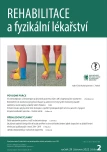Effectiveness of physiotherapeutic interventions in the treatment of patients with myogenic temporomandibular disorder with reduced jaw opening – a literature review
Authors:
Máca O.; Vymyslický P.; Pavlů D.
Authors‘ workplace:
Katedra fyzioterapie, Fakulta tělesné výchovy a sportu, Univerzita Karlova, Praha
Published in:
Rehabil. fyz. Lék., 29, 2022, No. 2, pp. 69-74.
Category:
Original Papers
doi:
https://doi.org/10.48095/ccrhfl202269
Overview
The aim of this review work was to identify the most effective therapeutic intervention to increase the range of motion of the mandible in the temporomandibular joint (MMO – maximal mouth opening) in patients with its myogenic disorder. The databases Scopus, PubMed, Web of Science and PEDro were used for the study and sources from 2011–2021 were included. A total of 390 articles were found based on the keywords, ,however, 12 studies met the defined criteria and were subjected to analysis. The results suggest that the most effective physiotherapeutic intervention to increase MMO in patients with myogenic temporomandibular disorder is the use of a low-power laser. Electrotherapy, combination therapy – exercise plus manual techniques, exercise alone and partly also soft tissue techniques were evaluated as other effective procedures.
Keywords:
temporomandibular disorder therapy – temporomandibular disorder – temporomandibular joint therapy – therapy of temporomandibular disorder – craniomandibular disorders
Sources
1. Machoň V. Léčba onemocnění čelistního kloubu. 1. vyd. Praha: Grada 2008. ISBN 978-802-4723-945.
2. Penas CF. Temporomandibular disorders. Manual therapy, exercise and needling. Handspring Publishing 2018. ISBN: 978-1-909141-80-3.
3. Çebi AT. Presence of tinnitus and tinnitus - related hearing loss in temporomandibular disorders. Cranio 2020; 1 : 1–5. doi: 10.1080/08869634.2020.1829290.
4. Harrison AL, Thorp JN, Ritzline PD. A proposed diagnostic classification of patients with temporomandibular disorders: implications for physical therapists. J Orthop Sports Phys Ther 2014; 44(3): 182–197. doi: 10.2519/jospt.2014.4847.
5. Travell J, Simons D, Simons L. Myofascial pain and dysfunction. 3. ed. Lippincott Williams and Wilkins 2018.
6. Kushagra M, Dua A. Temporomandibular syndrome. StatPearls Publishing 2019. [online]. Available from: https://www.ncbi.nlm.nih.gov/ books/NBK551612/.
7. Gross JM, Fetto J, Rosen E. Vyšetření pohybového aparátu. Praha: Triton 2005. ISBN 80-7254-720-8.
8. Máca O. Možnosti fyzioterapeutické intervence u pacientů s temporomandibulárních poruchou. Praha 2021. Diplomová práce. Univerzita Karlova, Fakulta tělesné výchovy a sportu, Fyzioterapie. Vedoucí práce Pánek, David.
9. National Health and Medical Research Council. NHMRC levels of evidence and grades for recommendations for developers of guide - lines. 2009. [online]. Available from: https://www.nhmrc. gov.au/sites/default/files/images/NHMRC%20 Levels%20and%20Grades%20(2009).pdf.
10. da Silva MAM, Botelho AL, Turim CV et al. Low level laser therapy as an adjunctive technique in the management of temporomandibular disorders. Cranio 2012; 30(4): 264–271. doi: 10.1179/crn.2012.040.
11. Sancakli E, Röhlig BG, Balik A et al. Early results of low-level laser application for masticatory muscle pain: a double-blind randomized clinical study. BMC Oral Health 2015; 15(1): 131. doi: 10.1186/s12903-015-0116-5.
12. Ahrari F, Madani AS, Ghafouri ZS et al. The efficacy of low-level laser therapy for the treatment of myogenous temporomandibular joint disorder. Lasers Med Sci 2014; 29(2): 551–557. doi: 10.1007/s10103-012-1253-6.
13. Herpich CM, Leal-Junior ECP, Politti F et al. Intraoral photobiomodulation diminishes pain and improves functioning in women with temporomandibular disorder: a randomized, sham-controlled, double-blind clinical trial: intraoral photobiomodulation diminishes pain in women with temporomandibular disorder. Lasers Med Sci 2020; 35(2): 439–445. doi: 10.1007/ s10103-019-02841-1.
14. Herpich CM, Lean-Junior ECP, Gomes CAF et al. Immediate and short-term effects of phototherapy on pain, muscle activity, and joint mo - bility in women with temporomandibular disorder: a randomized, double-blind, placebo-controlled clinical trial. Disabil Rehabil 2018; 40(19): 2318–2324. doi: 10.1080/09638288.2017. 1336648.
15. Saranya B, Ahmed J, Shenoy N et al. Comparison of Transcutaneous Electric Nerve Stimulation (TENS) and Microcurrent Nerve Stimulation (MENS) in the management of masticatory muscle pain: a comparative study. Pain Res Manag 2019 : 2019 : 8291624. doi: 10.1155/2019/8291624.
16. Tuncer AB, Ergun N, Tuncer AH et al. Effectiveness of manual therapy and home physical therapy in patients with temporomandibular disorders: a randomized controlled trial. J Bodyw Mov Ther 2013; 17(3): 302–308. doi: 10.1016/j.jbmt.2012.10.006.
17. Reynolds B, Puentedura EJ, Kolber MJ et al. Effectiveness of cervical spine high-velocity low-amplitude thrust added to behavioral education, soft tissue mobilization, and exercise for people with temporomandibular disorder with myalgia: a randomized clinical trial. J Orthop Sports Phys Ther 2020; 50(8): 455–465. doi: 10.2519/jospt.2020.9175.
18. Leite WB, Oliveira ML, Ferreira IC et al. Effects of 4-week diacutaneous fibrolysis on myalgia, mouth opening, and level of functional severity in women with temporomandibular disorders: a randomized controlled trial. J Manipulative Physiol Ther 2020; 43(8): 806–815. doi: 10.1016/j. jmpt.2020.01.002.
19. Kalamir A, Graham PL, Vitiello AL et al. Intra - -oral myofascial therapy versus education and self-care in the treatment of chronic, myogenous temporomandibular disorder: a randomised, clinical trial. Chiropr Man Therap 2013; 21 : 17. doi: 10.1186/2045-709x-21-17.
20. Rodriguez-Blanco C, Cocera-Morata FM, Heredia-Rizo AM et al. immediate effects of combining local techniques in the craniomandibular area and hamstring muscle stretching in subjects with temporomandibular disorders: a randomized controlled study. J Altern Complement Med 2015; 21(8): 451–459. doi: 10.1089/ acm.2014.0332.
21. Özden MC, Atalay B, Özden AV et al. Efficacy of dry needling in patients with myofascial temporomandibular disorders related to the masseter muscle. Cranio 2020; 38(5): 305–311: doi: 10.1080/08869634.2018.1526848.
Labels
Physiotherapist, university degree Rehabilitation Sports medicineArticle was published in
Rehabilitation & Physical Medicine

2022 Issue 2
Most read in this issue
- Rehabilitation treatment of lateral epicondylitis
- The effect of kinesio taping and kinesio therapy on dynamic gait parameters in children with hyperpronation syndrome
- Musculoskeletal disorders in wind instruments players
- Effectiveness of physiotherapeutic interventions in the treatment of patients with myogenic temporomandibular disorder with reduced jaw opening – a literature review
